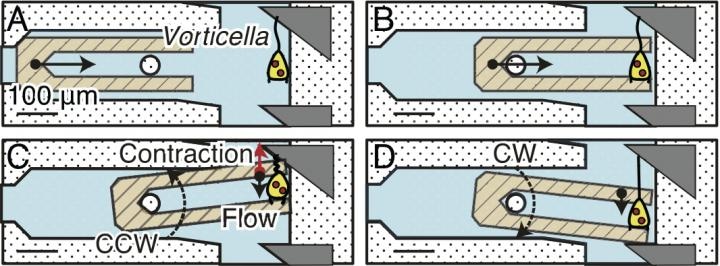Apr 15 2019
A study team at the Department of Mechanical Engineering at Toyohashi University of Technology has developed a technique to design a biohybrid system that integrates Vorticella microorganisms. The technique enables movable structures to be developed in a microchannel and integrated with Vorticella. Furthermore, the biohybrid system shows the conversion of motion from linear motion to rotation. The results of their study were reported in the IEEE/ASME Journal of Microelectromechanical Systems on April 11th, 2019.
 Integration of a structure with Vorticella (Upper, A, B). Repetitive movement of a structure due to the force of Vorticella and flow (Lower, C, D). (©Toyohashi University of Technology.)
Integration of a structure with Vorticella (Upper, A, B). Repetitive movement of a structure due to the force of Vorticella and flow (Lower, C, D). (©Toyohashi University of Technology.)
Complex control systems are necessary for the working of smart microsystems, and their sizes should be minimized. Cells are expected to be relevant as substitutes to these complex control systems. Since a cell incorporates a number of functions in its body and reacts to its surrounding setting, cells are smart and can be applied in smart micromechanical systems.
Particularly, Vorticella convallaria has a stalk (roughly 100 μm in length) that contracts and relaxes, and it functions as an autonomous linear actuator. The combination of stalks and movable structures will develop an autonomous microsystem. However, the construction of biohybrid systems in a microchannel is tough, as it is essential to establish a cell patterning technique and a biocompatible assembly process for the cell and structure.
The research team has formulated a technique to build a biohybrid system that includes Vorticella. "Harnessing microorganisms requires that a batch assembly method be applied to the movable components in a microchannel. It is necessary to pattern a water-soluble sacrificial layer and confine the movable components in a microchannel," says Moeto Nagai, a lecturer at Toyohashi University of Technology and the research team’s leader. Vorticella cells were positioned around blocks in the channel by applying magnetic force. These processes were applied to show how Vorticella changes the motion of a movable component.
The concept of harnessing a component to a microorganism seems simple, but it is difficult for even a microfabrication expert to make harnesses that can follow the motions of microorganisms. Hazardous chemicals should be avoided, and a multidisciplinary approach should be taken.
Moeto Nagai, Study Team’s Leader and Lecturer, Toyohashi University of Technology..
His team is acquainted with microfabrication and has carried out substantial research in the field of microbiology. They discovered a biocompatible method for making and discharging harnesses in a microchannel.
After permeabilized treatment, Vorticella stalks react to variations in calcium ion concentration, and they can function as calcium ion-responsive valves. The study team trusts that calcium ion-sensitive motors of Vorticella will enable the realization of autonomous fluidic valves, mixers, and regulators, as well as wearable smart microsystems, such as an automated insulin infusion pump for diabetes.